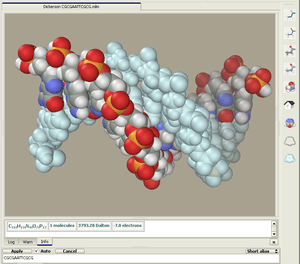Ascalaph Designer
|
Ascalaph Designer renders deoxyribonucleic acid (DNA) | |
| Original author(s) | Alexei Nikitin |
|---|---|
| Developer(s) | Agile Molecule |
| Stable release |
1.8.94
/ 3 December 2015 |
| Development status | Active |
| Written in | C++ |
| Operating system | Windows, Linux |
| Platform | x86 |
| Size | 138.9 MB |
| Available in | English |
| Type | Molecular modelling |
| License | GPLv2 |
| Website |
www |
Ascalaph Designer is a computer program for general purpose molecular modelling for molecular design and simulations. It provides a graphical environment for the common programs of quantum and classical molecular modelling ORCA, NWChem, Firefly, CP2K and MDynaMix[1] .[2] The molecular mechanics calculations cover model building, energy optimizations and molecular dynamics. Firefly (formerly named PC GAMESS)[3][4][5] covers a wide range of quantum chemistry methods. Ascalaph Designer is free and open-source software, released under the GNU General Public License, version 2 (GPLv2).[6]
Key features
- Molecular model building: polymers, nanotubes, proteins, nucleic acids
- AMBER-OPLS force field family
- Geometry optimization
- Molecular dynamics
- Quantum chemistry
- Flexible SPC[7] water model
Uses
- Nucleic acids[8]
- Proteins
- Modeling lipid bilayers[9]
- Polyelectrolytes[10]
- Ionic liquids[11][12]
- Thermodynamic properties of liquids[13]
- Chemical force field development[14]
See also
References
- ↑ A.P.Lyubartsev, A.Laaksonen (2000). "MDynaMix - A scalable portable parallel MD simulation package for arbitrary molecular mixtures". Computer Physics Communications. 128 (3): 565–589. Bibcode:2000CoPhC.128..565L. doi:10.1016/S0010-4655(99)00529-9.
- ↑ A.P.Lyubartsev, A.Laaksonen (1998). "Parallel molecular dynamics simulations of biomolecular systems". Applied Parallel Computing Large Scale Scientific and Industrial Problems. Lecture Notes in Computer Science. 1541. Heidelberg: Springer Berlin. pp. 296–303. doi:10.1007/BFb0095310. ISBN 978-3-540-65414-8.
- ↑ Computational Chemistry, David Young, Wiley-Interscience, 2001. Appendix A. A.2.3 pg 334, GAMESS
- ↑ M.W. Schmidt; et al. (1993). "General Atomic and Molecular Electronic Structure System". J. Comput. Chem. 14 (11): 1347–1363. doi:10.1002/jcc.540141112.
- ↑ M. S. Gordon and M. W. Schmidt, Advances in electronic structure theory: GAMESS a decade later, in Theory and Applications of Computational Chemistry, the first 40 years, C. E. Dykstra, G. Frenking. K. S. Lim and G. E. Scusaria, Elsevier, Amsterdam, 2005.
- ↑ http://sourceforge.net/projects/asc-designer/
- ↑ Toukan K & Rahman A (1985). "Molecular-dynamics study of atomic motions in water". Physical Review B. 31 (5): 2643–2648. Bibcode:1985PhRvB..31.2643T. doi:10.1103/PhysRevB.31.2643.
- ↑ Y. Cheng, N. Korolev & L. Nordenskiöld (2006). "Similarities and differences in interaction of K+ and Na+ with condensed ordered DNA. A molecular dynamics computer simulation study". Nucleic Acids Research. 34 (2): 686–696. doi:10.1093/nar/gkj434. PMC 1356527
 . PMID 16449204.
. PMID 16449204. - ↑ C.-J. Högberg; A.M.Nikitin and A.P. Lyubartsev (2008). "Modification of the CHARMM force field for DMPC lipid bilayer". Journal of Computational Chemistry. 29 (14): 2359–2369. doi:10.1002/jcc.20974. PMID 18512235.
- ↑ A. Vishnyakov & A.V. Neimark (2008). "Specifics of solvation of sulfonated polyelectrolytes in water, dimethylmethylphosphonate, and their mixture: A molecular simulation study". J. Chem. Phys. 128 (16): 164902. Bibcode:2008JChPh.128p4902V. doi:10.1063/1.2899327. PMID 18447495.
- ↑ G. Raabe & J. Köhler (2008). "Thermodynamical and structural properties of imidazolium based ionic liquids from molecular simulation". J. Chem. Phys. 128 (15): 154509. Bibcode:2008JChPh.128o4509R. doi:10.1063/1.2907332. PMID 18433237.
- ↑ X. Wu; Z. Liu; S. Huang; W. Wang (2005). "Molecular dynamics simulation of room-temperature ionic liquid mixture of [bmim][BF4] and acetonitrile by a refined force field". Phys. Chem. Chem. Phys. 7 (14): 2771–2779. Bibcode:2005PCCP....7.2771W. doi:10.1039/b504681p. PMID 16189592.
- ↑ T. Kuznetsova & B. Kvamme (2002). "Thermodynamic properties and interfacial tension of a model water–carbon dioxide system". Phys. Chem. Chem. Phys. 4 (6): 937–941. Bibcode:2002PCCP....4..937K. doi:10.1039/b108726f.
- ↑ A.M. Nikitin & A.P. Lyubartsev (2007). "A new six-site acetonitrile model for simulations of liquid acetonitril and its aqueous mixture". J. Comp. Chem. 28 (12): 2020–2026. doi:10.1002/jcc.20721. PMID 17450554.
External links
This article is issued from Wikipedia - version of the 9/24/2016. The text is available under the Creative Commons Attribution/Share Alike but additional terms may apply for the media files.
